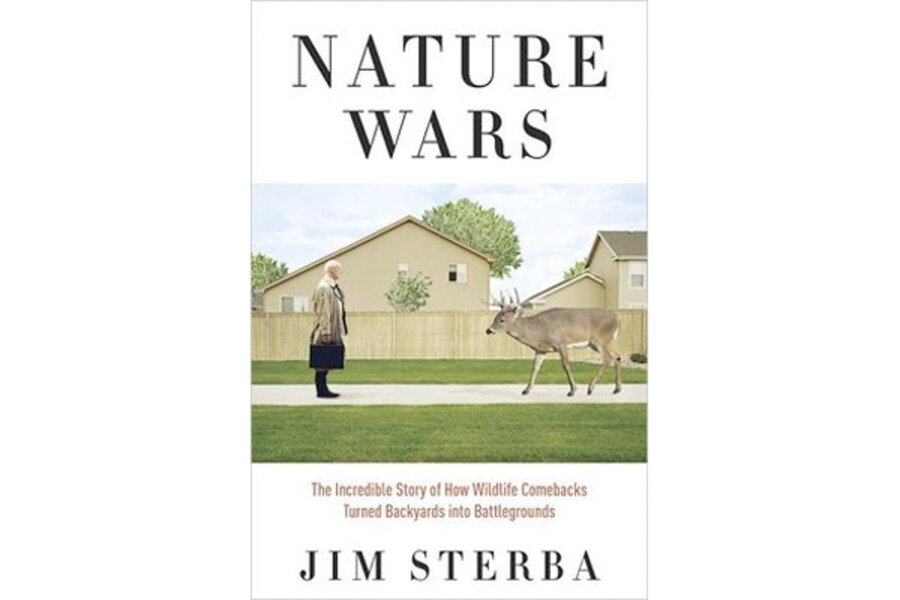Nature Wars
Let’s cut to the chase, shall we? As a boy, Jim Sterba didn’t shed a tear for Bambi’s mother, who famously was killed by a hunter. Today, not just deer but other woodland creatures are in his crosshairs: “It’s clear that a lot more of them have to die, especially Bambi’s mom and other females, in order to lower their populations in areas where they cause damage.”
Sterba, a journalist, is the author of Nature Wars: The Incredible Story of How Wildlife Comebacks Turned Backyards into Battlegrounds, and his thesis is simple: sometimes to help a species – and to keep it from harming other species, including us – nature must be managed. How Americans feel about how, when, and even if this should be attempted takes up much of his second book.
But first Sterba documents how the eastern United States has experienced an ecological rollercoaster during the past century: from deforestation and species decline to burgeoning woodlands and miraculously rebounding animal populations in recent decades. We Easterners – urban, suburban, and rural alike – are a forest people, whether or not we fully appreciate that reality; for example, nearly a quarter of New York City’s five boroughs are covered with trees, according to the author. More than 60 percent of Connecticut, the fourth densest state, is under a green canopy. Our neighbors include bears, moose, beavers, coyotes, seemingly incontinent geese, and those aforementioned ubiquitous ungulates. We bump into them all the time. A mountain lion was killed by a car in Connecticut in 2011.
What’s more, many of us who have migrated to the country or leafy burbs are tenderfoots: We like the scenery but we don’t hunt or farm or even get out in nature all that much. We drive back and forth to work and the store a lot. According to the author, “Americans now spend 90 percent of their time indoors, and they pay more heed to the nature conveniently packaged on their electronic screens than to the nature around them.”
But nature has a way of paying attention to us. Resurgent beavers can flood our roads, deer can total our Volvos, coyotes can feast on Fluffy, wild turkeys can damage crops, and Canada geese can bring down airplanes. What Sterba aptly describes as a “moment of clarity” in the contentious debate over how to manage proliferating geese arrived in 2009 when US Airways Flight 1549 sucked a flock into both engines and crash-landed in the Hudson River. Everyone survived (although not the $60 million plane); others have not been as lucky in recent years.
Sterba brings the perspective of a Midwestern country boy to the debate over what to do about our overabundance of wildlife – at least certain species in certain places in our Eastern woodlands, where he now lives. The author grew up on a Michigan farm, where he hunted and fished, at a time when pets were pets rather than pampered members of the family. Nature to him was real, not a sentimental Disney film, and he clearly thinks many of us don’t have sufficient real-world knowledge to back up our often strident opinions about environmental stewardship.
“Species partisanship” can be every bit as contentious and irrational as the Beltway variety. Take feline fanatics: Try convincing them that feral cats and their free-range domestic cousins are anything but upstanding darlings worry of protection. The Audubon Society and the American Bird Conservancy make a pretty good case that these interlopers gone wild (as many as 100 million strong) are an invasive species that kills 500 million or more birds in the United States every year.
While advancing his brief that mankind has to do more to intervene as managers in the natural process, Sterba also ably documents how we influence wildlife without really trying or realizing it. We may not want hunters or hired sharpshooters killing deer in our towns, but our vehicles will cull the expanding herd all the same. Indeed, our roadways are magnets for many creatures that are drawn there to feed and end up as road kill. When we feed bears or coyotes in our yards – intentionally with jelly donuts or thoughtlessly by making our garbage easy pickings – we affect their behavior and put both them and ourselves in danger.
Even our beloved bird feeders (Americans spend nearly $5 billion annually for the birds) come under scrutiny: They can facilitate the spread avian diseases, provide an avian buffet for neighborhood hawks and cats, and attract unwanted freeloaders such as bears.
It is easy to appreciate why many people are skeptical of increased human intervention in the natural world. Our past sins are well documented and our current ones are despoiling countless wild places around the planet. At some point soon, if it is not there already, our species may be added to the endangered list. The good news is that the Eastern United States is proof that not all environmental degradation is irreversible and that our dominion over the earth need not preclude the well-being of our fellow creatures. Learning how best to live with our new neighbors is clearly a work in progress.
David Holahan is a regular contributor to the Monitor's Books section.






